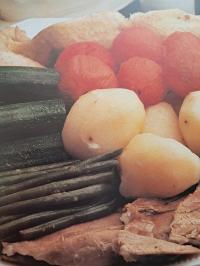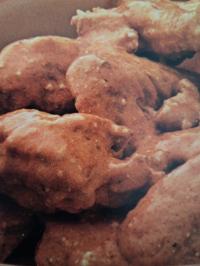Copy Link
Add to Bookmark
Report
Lambic Digest #0365

From postmaster at longs.lance.colostate.edu Wed Jun 8 03:16:48 1994
Received: from longs.lance.colostate.edu by goodman.itn.med.umich.edu with SMTP id AA27064
(5.65b/IDA-1.4.3 for spencer at hendrix.itn.med.umich.edu); Wed, 8 Jun 94 03:16:39 -0400
Received: from localhost (daemon at localhost) by longs.lance.colostate.edu (8.6.5/8.6.5a (LANCE 1.01)) id AAA06958 for reallambic at longs.lance.colostate.edu; Wed, 8 Jun 1994 00:30:08 -0600
Message-Id: <199406080630.AAA06958 at longs.lance.colostate.edu>
Reply-To: lambic at longs.lance.colostate.edu (postings only - do not send subscription requests here)
Errors-To: lambic-request at longs.lance.colostate.edu
From: lambic-request at longs.lance.colostate.edu (subscription requests only - do not post here)
To: lambic at longs.lance.colostate.edu
Subject: Lambic Digest #365 (June 08, 1994)
Date: Wed, 8 Jun 1994 00:30:08 -0600
Lambic Digest #365 Wed 08 June 1994
Forum on Lambic Beers (and other Belgian beer styles)
Mike Sharp, Digest Coordinator
Contents:
Kulminator pub lambic selections - 2 (Stephen George)
Re: misc lambics (Jim Busch)
Flanders Brown & L. delbruckii (Mark Stickler)
turbid mashing -- an observation/question (Michael Sharp)
All set to lose my virginity (brewing chemist Mitch)
Send article submissions only to: lambic at longs.lance.colostate.edu
Send all other administrative requests (subscribe/unsubscribe/change) to:
lambic-request at longs.lance.colostate.edu
Back issues are available by mail; send empty message with subject 'HELP' to:
netlib at longs.lance.colostate.edu
A FAQ is also available by netlib; say 'send faq from lambic' as the
subject or body of your message (to netlib at longs.lance.colostate.edu).
----------------------------------------------------------------------
Date: 07 Jun 94 06:43:15 EDT
From: Stephen George <74363.26 at CompuServe.COM>
Subject: Kulminator pub lambic selections - 2
Here's part two of the Kulminator pub's Lambic selections. As I live in Antwerp, I tend
to patronize this place more than any other. I will make a later posting with some
observations about other 'hot spots' on the Flanders circuit.
Krieken Lambic:
Cantillon 1985 750 ml 220 BeF
Kriek (with bottlecap):
Kriek primeur 1994 25 ml 72 BeF
Kriek (with cork, 750 ml):
Bruegel 160 BeF
De Troch 150 BeF
Boon 160 BeF
Boon Mariage Parfait 1983 360 BeF
Boon Mariage Parfait 1976-78 950 BeF
Cantillon 1985 245 BeF
De Neve 245 BeF
Eylenbosch 1978 700 BeF
Lindemanns 250 BeF
Mort Subite 230 BeF
Framboise (all but the first, 750 ml):
Gueuze Framboise des Ardennes 375 ml 175 BeF
Boon 1983 350 BeF
Boon Geb. 1978 900 BeF
Cantillon 1985 300 BeF
Cantillon 1979 700 BeF
Eylenbosch 330 BeF
Ambrosius Eylenbosch 1979 650 BeF
Lindemanns 350 BeF
Timmermans 1985 330 BeF
Van den Linden 1987 300 BeF
------------------------------
Date: Tue, 7 Jun 1994 10:04:58 -0400 (EDT)
From: Jim Busch <busch at daacdev1.stx.com>
Subject: Re: misc lambics
> Veredelde Gueuze (miscellaneous types ?):
>
> Druivenbier Eylenbosch (grape)
Brabantia and Mozart are specials from Cantillion, right?
Brabantia is aged in old Port barrles.
> Cuvee Brabantia
> Cuvee Mozart
> Der Zeven Naties (Cantillon Druivenbier) 370 BeF
Any info on what this one is? More grape "juice" experiments
by Cantillion? Do they still make Vigneronne (also a grape based
lambic)?
Jim B.
------------------------------
Date: Tue, 7 Jun 94 11:27:21 EDT
From: Mark Stickler <mstickle at lvh.com>
Subject: Flanders Brown & L. delbruckii
I forgot to save a copy of the digest but I believe someone (Arron?)
asked about making Flanders Brown and using L.delbruckii. Here is my
experience, all using cultures from Head Start Brewing.
I made an attempt at Flanders/Brown last week using the following
grain bill (loosely based on Rajotte's Oud Bruin recipe):
1 lb. Oats
1 lb. Unmalted Wheat
8 lbs. Breiss 2-Row
4 ozs. Special-B
This was for 5 gallons. Per Rajotte I boiled/simmered for almost 4 hours
and sure enough the stuff came out about as Red as Rodenbach! I used
a Head Start's Flanders Brown culture which I believe has an L. delbruckii
strain "built-in". It did take about two-weeks to grow-up into a 1 quart
starter and smelled bad/tasted good when I pitched it. I will let you know
if it turns out sour (good) in a month or so.
I also used Head Start's Belgian Wit strain and a separate L. delbruckii
strain to attempt a Hoegaarden clone. The instructions indicated that
the L. delbruckii be grown in something called MRS supplement (Head Start
sells this) at 97 degrees F. That was a problem for me. What I did was
find an old yogert maker and place it in/on there. I don't think it was
warm enough. I propagated this over four five gallon batches. Sometimes
when I pitched it it smelled sour and sometimes not. I have only sampled
the third batch which I kegged last week (the other three were bottled).
My records show that it didn't smell sour when pitching in this batch and
when I tasted it, while being pretty good due to the use of bitter orange
peels, it did not taste very tart. I'll let you know how the bottles turn
out.
Any other ideas on keeping L. delbrukii happy?
Mark Stickler
mstickler at lvh.com
------------------------------
Date: Tue, 7 Jun 94 10:26:21 PDT
From: msharp at Synopsys.COM (Michael Sharp)
Subject: turbid mashing -- an observation/question
Hi folks,
A point to ponder:
A turbid mash appears to be similar to a decoction but without
using the drawn off liquid to raise the temperature of the main mash
(leaving a very thin mash as previously commented on by many).
[this diagram appeared before -- I'm going to refer to it so I thought
I'd just put it in here]
Malt Wheat Water
==== ===== =====
Milling Milling 500L
100kg | 55C
| | |
+-----------------> Mash at 45C <--------------+
|
| <---- addition H20 at 90C
|
Mash at 52C
|
Taking of <----------------+ <---- addition h20 at 90C
turbid mash |
| Mash at 65C
| |
Taking of <----------------+ <---- addition H20 at 90C
turbid mash |
| Mash at 72C
| |
Taking of <----------------+
turbid mash |
| |
Heating to 85C ----------->|
|
Filtration at 78C
|
| <---- washing with H20 of
| 95C (in lauter tun)
|
(5-6h) boiling - annuated hops
| 3kg/500L
|
Hop - sieve - filter in coolship
Cooling and air-inocculation
|
|
Fermentation in wooden barrels or
wood-coated tanks
The diagram shows 'taking of turbid mash' three times and then we heat to
85C and add back at the end of the mash.
Question: Shouldn't the flow of this portion of the chart really be:
Taking of <----------------
turbid mash
|
heating to 85C
|
Taking of <----------------
turbid mash
|
heating to 85C
|
Taking of <----------------
turbid mash
|
heating to 85C ----------->
Why do I ask this? Well, if all you do is pull off the liquid and hold it
while continuing the main mash aren't you allowing the enzymes in the liquid
to continue converting the sugars/starches that have been extracted?? Isn't
this counter to the reason for doing a turbid mash in the first place??
- --ALSO--
What about the sparge and the volume of liquid we've got??
How about this:
What really happens can be thought of as a sparge in steps at different
temperatures. When it comes down to the final steps the chart should
read:
pull off what liquid remains
in the mash at 75C
|
_LIGHTLY_ sparge at 95C
(remember, most of the sugars
have already been removed by
previous 'taking of turbid mash'
steps. the volume of water
needed is much less than a
'normal' sparge)
|
heating to 85C ---------------> |
|
boil
(note the liquid portion being tansfered directly to the boil and not
filtered through the grain bed)
Comments??? Am I a genious or an idiot? (or is this obvious and I'm
just slow?)
(I feel real silly about not having seen this earlier.)
--Mike
------------------------------
Date: Tue, 7 Jun 1994 13:36:56 -0500 (CDT)
From: gellym at aviion.persoft.com (brewing chemist Mitch)
Subject: All set to lose my virginity
Okay. Deep breath. Dive in.
I have gathered most of the necessary ingredients, and am ready to careen
headlong into a plambic. I was grepping back through the digests (all the way
back to # 0), and was kind of dismayed by not seeing *too* many recipes. But,
from what I have read, and by talking to people, I have (I think) formulated a
recipe. If you see anything here that strikes you as odd or blatantly wrong,
_please_ feel free to slap me around a bit.
(10 gallons)
7 lbs D-C pale ale malt
7 lbs Breiss blend (2-row and 6-row mix) pils malt
9 lbs soft red winter wheat
3 oz, aged hops (tettnang or hallertau, I've got both)
I plan on cooking the wheat, then mashing with the rest of the grain. I have
never decocted, and probably will not get the chance before this batch, so I
do not want to experiment with that at this time. I will do a temperature
controlled step mash. For the yeasts & beasts, I plan on this schedule:
Initial pitch with Chico ale yeast.
After a week or two, pitch starter of GW Kent B.Brux and a starter of Pedio
I am also going to make up a starter and pitch the dregs of a few selected
Belgians into it - I have bottles of Cantillon gueuze and Rose de Gambrinus,
F. Boon faro, kriek, and gueuze. What do you think, drink five bottles and
pitch the dregs from all ? Might not be economical, but would be damn tasty to
do.
Let all this go for 8 - 12 months, then rack onto cherries and/or raspberries.
So. Where have I gone wrong, or right? Do I have a decent plan or not ?
Thanks,
Mitch (plambic brewer wannabe)
- --
| - Mitch Gelly - | Zack Norman |
| software QA specialist, systems administrator, zymurgist, | is |
| AHA/HWBTA beer judge, & president of the Madison Homebrewers | Sammy in |
| - gellym at aviion.persoft.com - gelly at persoft.com - | Chief Zabu |
------------------------------
End of Lambic Digest
************************
-------
























